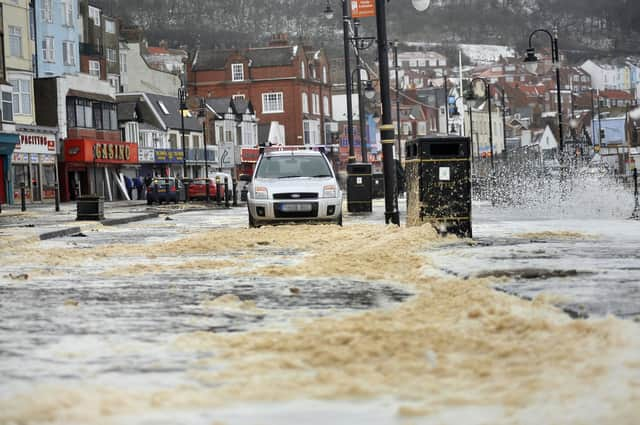How to deal with flooding: Storm Gerrit warnings and advice from officials for Yorkshire coast residents


Heavy rain and localised flooding is expected in North Yorkshire and the Yorkshire coast,
The Met Office has issued a Yellow Weather Warning for Rain across the county. Visit here for more information about flood warnings on the Yorkshire coast, including Scarborough and Whitby.
Advertisement
Hide AdAdvertisement
Hide AdNorth Yorkshire Fire and Rescue service (NYFRS) said: “We thought it would be helpful to share some information about flooding, and what to do, if you are affected by floodwater.
“The areas most likely to be affected include Malton, York, Boroughbridge, Tadcaster, Hunsingore and Selby.
“Most of these areas are likely to see their rivers peaking Thursday.
“Flooding can be a scary experience, whether it is the first time your property has been flooded, or even if it has happened before. This is why we wanted to provide you with some helpful advice and information, which may help you prepare, if your home is liable to flooding.
Advertisement
Hide AdAdvertisement
Hide Ad“For information local to York and North Yorkshire, please visit the North Yorkshire Council website here Flooding | North Yorkshire Council.
“There is a lot of helpful toolkits and checklists available on the Flood Hub website to, which can be found at www.thefloodhub.co.uk
Some important points to consider, are:
- Create a household flood plan (a template can be found on the Flood Hub website)
- Sign up to receive flood alerts and warnings
- Investigate property flood resilience options
- Check your insurance covers flood damage
- Put important documents in a safe place away from flood risk but somewhere you would have access too in case of an emergency
- Prepare an emergency bag and flood kit
- Ensure pets are microchipped and consider where you could send them if you need to evacuate.
Insurer and road safety campaigner NFU Mutual is urging drivers to take extra care as they travel during the next few days.
Andrew Chalk, rural road safety specialist at NFU Mutual, said: "The rain and high wind brought by Storm Gerrit will hot most of the United Kingdom and will only increase the common hazards like mud and debris on the road, reduced visibility of corners and junctions, uneven road surfaces and narrow roads.
Advertisement
Hide AdAdvertisement
Hide Ad"Coupled with the fact many people will be using rural roads at this time of year who may not be used to them, we're concerned that this Christmas period could be marred by unwelcome injuries and fatalities.
"Don't take unnecessary risks in this weather - make sure you're well rested and take your time when driving, avoid the roads unless you need to use them and pay attention for other road users and hazards such as uneven road surfaces, blind corners and junctions and mud and other hazards. Getting home or to family a few minutes earlier is not worth a potentially life-changing accident."
NFU Mutual has issued guidance for all those using rural roads, some things for motorists to look out for are:
- Speed limits, not targets – designated speed limits are provided as a maximum legal guide, however, hazards such as sharps bends, animals on the road and changing conditions often mean that drivers should determine their speed by the circumstances, rather than the speed limit.
- Winding roads – when driving on twisting roads, slow your car ahead of the bend to a speed which will allow you to stop should a hazard emerge around the corner.
- Mud on the road – Mud, along with wet leaves, can be incredibly slippery in wet conditions; you should exercise caution and reduce your speed.
- Manure on the road – Spotting a fresh pile of manure should alert you to the possibility that horses are not far away. Drivers should slow down and be prepared to stop if necessary.
- Reacting to wildlife – look out for signs that indicate you may encounter wildlife. If you do, your natural instinct might be to swerve to avoid a rabbit or pheasant, but this is dangerous and could cause a serious collision due to losing control of your vehicle. Larger animals present a bigger problem. If there’s no oncoming traffic then sounding your horn may startle the animal to move safely out of the way, whilst braking could reduce the severity of an impact, but always be mindful of vehicles behind you.
- Farm traffic – tractors and farm machinery on the road can be frustrating for drivers caught up in a queue. However, usually a tractor will not be travelling too far up the road, so it won’t be long before the road is clear again. If you do decide to overtake, make absolutely sure the road ahead is clear and consider any junctions ahead that motorists may pull out from. Due to their size, tractors might swing out to the right before turning left, be aware of this before making the decision to overtake.
- Ice on or under bridges – the road surface on bridges will be the first to freeze when the temperate drops, whilst roads that run underneath them will often be the last to thaw. Consider your speed and stopping distance in icy conditions.